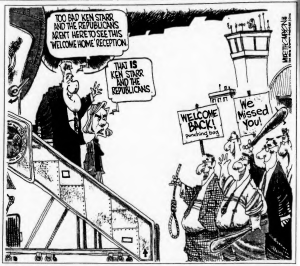Primary Source Set
Analyzing Political Cartoons
One of the ways that newspaper publishers express their views is through political cartoons. This editorial form became popular over the 20th century for the way it can quickly and forcefully deliver a viewpoint to its audience—particularly in decades when not all adults could read. This primary source set uses examples of political cartoons from school and community newspapers to show how the form has evolved over the last 100 years.
Proceed with caution and care through these materials as the content may be disturbing or difficult to review. Please read DigitalNC’s Harmful Content statement for further guidance.
Time Period
20th Century
Grade Level
9 – 12
The News-Journal (Raeford, N.C.), July 22, 1998
Caricatures of public figures became more prominent in political cartoons in the second half of the 20th century. This example is from July 1998, the beginning of an investigation into claims of sexual assault by President Bill Clinton. In this cartoon, Clinton is shown stepping off an airplane with his wife, Hillary Clinton. Ken Starr, the person they are talking about, was the lawyer (known as independent counsel) who was investigating President Clinton.
A few months later, in September 1998, Congress charged President Clinton with four articles of impeachment—crimes such as lying under oath and obstructing justice—to try to remove him from office. While this cartoon was published before the impeachment process began, it captures some of the political tension between Clinton (a Democrat) and Republicans in Congress. This cartoon was drawn for a national audience by Mike Thompson.
Contributed to DigitalNC by Hoke County Public Library, University of North Carolina at Chapel Hill
Raeford, N.C. (Hoke County)
Background
Many newspapers in the 20th and 21st centuries include editorial sections designed to make arguments or give opinions about topics in the news. One way for newspaper editors to present an opinion is through political cartoons. While these cartoons can be funny and entertaining, their primary purpose is to quickly make an argument about a political or social issue. Political cartoons can be found in all kinds of newspapers published in many different countries and can be used to address any issue that the audience of the newspaper recognizes. Many times, the artists address polarizing issues with cartoons or push the boundaries in an effort to evoke a reaction from readers.
Political cartoons often use some of the same rhetorical devices as written articles, including irony, symbolism, and analogy. Cartoons also have their own rhetorical devices, such as exaggerating characteristics of a particular person and labeling things to tell you what they represent. Sometimes, the meaning of the cartoon is made clear through a short title or caption. Additionally, understanding political cartoons usually requires knowing their contexts. Many of them contain representations of famous people or references to historical events. It may also help to know the intended audience of the newspaper.
Note: Some political cartoons depict stereotypes that may be uncomfortable to see. While the examples in this set avoid offensive imagery as much as possible, other pages of these newspapers may include it.
Discussion Questions
What do you see in this cartoon? Who are the characters? What are they doing?
What rhetorical devices is this cartoonist using? What elements are exaggerated or humorous?
What is the argument the cartoon is making? How do you know?
What does this cartoon tell you about this newspaper? Who is their primary audience? What viewpoints do they want to convey?
Do you find the cartoon’s point persuasive? Why or why not?
This primary source set was compiled by Sophie Hollis.
Updated January 2025
